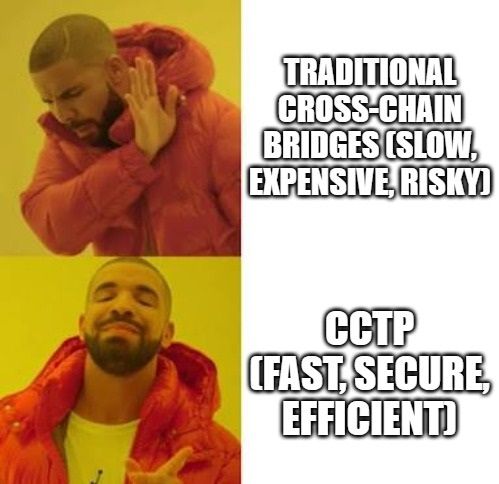Decentralized finance (DeFi) is a bustling ecosystem teeming with innovation. However, one major challenge has been the easy transfer of digital assets across different blockchains. Circle, the issuer of the popular USDC stablecoin, is tackling this recurring issue head-on with its innovative Cross-Chain Transfer Protocol (CCTP).
Let’s look at CCTP's technology, how it aligns perfectly with the stablecoin narrative, its impact on adoption, and how it intertwines with Solana's recent success.
The time has come for the United States to lead the development of global rules that will determine how the U.S. dollar moves on the internet. If the dollar is going to remain the world’s reserve currency, then we need to build trust in digital dollars & regulate stablecoins… pic.twitter.com/ZYOZ5X3nXg
— Circle (@circle) July 13, 2023
What is CCTP?

CCTP operates on a permissionless, on-chain foundation, facilitating secure USDC transfers between various blockchains. Here's the magic behind it:
Burning Native USDC: The process begins on the source chain (the blockchain where the USDC currently resides). Users initiate a transaction to burn (effectively destroy) the desired amount of USDC.
Attestation Fetching: Following the burn, the CCTP app retrieves a signed attestation from Circle. This attestation serves as cryptographic proof that the USDC was indeed burned on the source chain.
Minting on the Destination Chain: Armed with the attestation, the app interacts with the destination chain's smart contract. This smart contract verifies the authenticity of the attestation from Circle and authorizes the minting of the same amount of USDC on the destination chain.
Delivery to Recipient: The newly minted USDC on the destination chain is then delivered to the recipient's wallet address, completing the cross-chain transfer.
CCTP shines compared to traditional bridging solutions by eliminating the need for locked tokens or synthetic versions of USDC. This approach minimizes trust assumptions whilst ensuring greater capital efficiency.
CCTP and the Stablecoin Narrative

Stablecoins, cryptocurrencies pegged to a stable asset like the US dollar, have gained significant shareholdings in DeFi due to their price stability. They bridge the gap between the volatility of traditional cryptocurrencies and the familiarity of fiat currencies. CCTP perfectly complements this narrative by:
- Facilitating USDC Adoption Across Chains: CCTP removes barriers to entry for users holding USDC on different blockchains. They can now easily transfer their USDC to participate in DeFi opportunities on other blockchains without having to convert to another asset.
- Enhancing Liquidity: By enabling seamless cross-chain transfers, CCTP contributes to increased liquidity for USDC across various DeFi ecosystems. This benefits both users and developers by creating a more vibrant and efficient market for the stablecoin.
- Promoting Interoperability: CCTP makes way for a more interconnected DeFi landscape. By streamlining USDC movement between blockchains, it encourages collaboration and innovation across different DeFi protocols.
How CCTP is Shaping the Future of Adoption
CCTP's innovative approach is gaining traction within the blockchain community. Here are some key aspects that are driving its adoption:
- Integration with Leading Blockchains: Circle has strategically partnered with prominent blockchains like Ethereum, Solana, Arbitrum, Avalanche, and others to integrate CCTP. This broadens the reach of USDC and simplifies cross-chain transfers for a wider user base.
- Enhanced Security: CCTP leverages Circle's established reputation and robust infrastructure, offering users peace of mind regarding the security of their cross-chain transactions.
- Improved User Experience: By eliminating the complexities of traditional bridging solutions, CCTP provides a user-friendly experience for transferring USDC across different blockchain environments.
The Solana and CCTP Connection
1/ Recently, stablecoins issued on the Solana network surpassed $3B USD — and congrats to @Circle passing the $2B issuance mark for USDC on Solana!🔥
— Solana (@solana) April 8, 2024
Stablecoins are a killer use-case for Solana and it still has lots of room to grow👇🧵 pic.twitter.com/EUb19yj4s7
Solana, a pioneer for fast transaction speeds and low fees, has been experiencing a massive rise in its popularity. This rise blends perfectly with the adoption of CCTP on the Solana network. Here's how they work together:
- Efficiency Boost: CCTP's native USDC transfers perfectly complement Solana's efficient architecture. Users can now enjoy the benefits of both – the stability of USDC and the speed of Solana for their DeFi activities.
1/ We’re excited to announce our upcoming support for Web3 Services on @Solana!
— Circle (@circle) April 8, 2024
Stablecoins like $USDC are creating a more open and inclusive financial system. We’re committed to enabling enterprises and builders with the tools needed to make USDC accessible to all. pic.twitter.com/74AEuiWKe8
- Increased Liquidity for Solana DeFi: By attracting more USDC holders to the Solana ecosystem, CCTP contributes to increased liquidity for DeFi applications built on Solana like Jupiter, Drift Protocol, Marginfi, Kamino and Marinade. This makes it a more attractive environment for developers and users alike.
2/ Data from @Artemis_xyz as of Apr. 4th, 2024 shows that stablecoin issuance and transfers on the Solana network have continued to rise over the past three months, with over 3.1 billion issued and millions of daily transfers.
— Solana (@solana) April 8, 2024
Stablecoins are just getting started on Solana 💪 pic.twitter.com/pbAsMJLEKa
- Mutual Success: The synergy between CCTP and Solana is mutually beneficial. CCTP takes advantage of Solana's growing user base and adoption, while Solana benefits from the increased liquidity and DeFi activity driven by USDC transfers.
The Future of Money
The success of CCTP and its integration with leading blockchains like Solana highlight a significant shift in the DeFi landscape. As cross-chain transfers become easier to perform while improving efficiency, we can expect further innovation and wider adoption of stablecoins and DeFi applications across Web3.
If CCTP fosters wider adoption of USDC across various blockchains, it could lead to increased use of USDC by businesses for international settlements or other financial activities. This could indirectly benefit banks that offer USDC custody or trading services.